Page 185 of 371
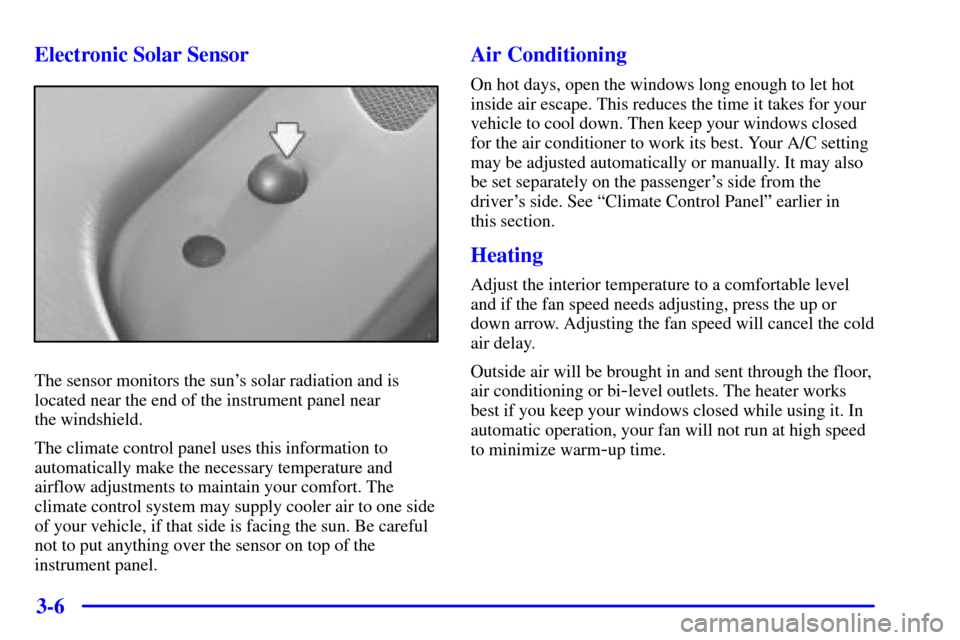
3-6 Electronic Solar Sensor
The sensor monitors the sun's solar radiation and is
located near the end of the instrument panel near
the windshield.
The climate control panel uses this information to
automatically make the necessary temperature and
airflow adjustments to maintain your comfort. The
climate control system may supply cooler air to one side
of your vehicle, if that side is facing the sun. Be careful
not to put anything over the sensor on top of the
instrument panel.
Air Conditioning
On hot days, open the windows long enough to let hot
inside air escape. This reduces the time it takes for your
vehicle to cool down. Then keep your windows closed
for the air conditioner to work its best. Your A/C setting
may be adjusted automatically or manually. It may also
be set separately on the passenger's side from the
driver's side. See ªClimate Control Panelº earlier in
this section.
Heating
Adjust the interior temperature to a comfortable level
and if the fan speed needs adjusting, press the up or
down arrow. Adjusting the fan speed will cancel the cold
air delay.
Outside air will be brought in and sent through the floor,
air conditioning or bi
-level outlets. The heater works
best if you keep your windows closed while using it. In
automatic operation, your fan will not run at high speed
to minimize warm
-up time.
Page 187 of 371
3-8 Ventilation System
Your vehicle's flow-through ventilation system supplies
outside air into the vehicle when it is moving. Outside
air will also enter the vehicle when the heater or the air
conditioning fan is running.
The front outlets are located in the center and at each
side of the instrument panel. You can adjust the
direction of airflow by moving the center control levers
or you can stop the airflow by moving the thumbwheel
located on each outlet downward.Rear Ventilation
The direction and quantity of airflow for the rear seats
can also be adjusted at the back of the console. Heater
outlets are located under the front seat to warm the feet
of rear passengers.
Move the fan lever to adjust the blower speed from LO
to HI. Adjust the knob to direct the air flow. To reduce
airflow to the rear outlets, slide the fan lever all the way
to the left. Turning the knob to OFF will completely
stop airflow, no matter where the fan blower control
is set.
Page 188 of 371
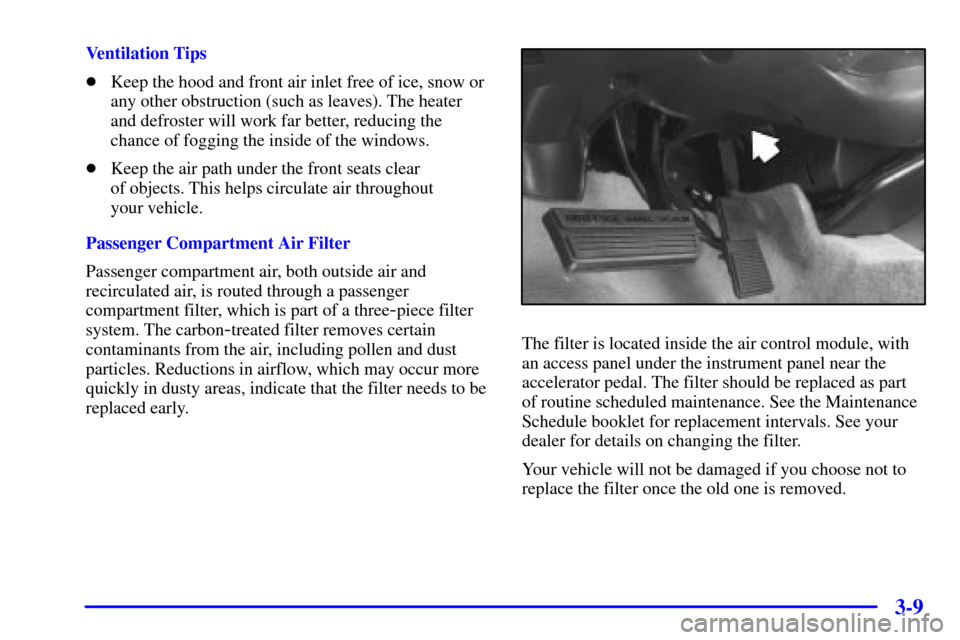
3-9
Ventilation Tips
�Keep the hood and front air inlet free of ice, snow or
any other obstruction (such as leaves). The heater
and defroster will work far better, reducing the
chance of fogging the inside of the windows.
�Keep the air path under the front seats clear
of objects. This helps circulate air throughout
your vehicle.
Passenger Compartment Air Filter
Passenger compartment air, both outside air and
recirculated air, is routed through a passenger
compartment filter, which is part of a three
-piece filter
system. The carbon
-treated filter removes certain
contaminants from the air, including pollen and dust
particles. Reductions in airflow, which may occur more
quickly in dusty areas, indicate that the filter needs to be
replaced early.The filter is located inside the air control module, with
an access panel under the instrument panel near the
accelerator pedal. The filter should be replaced as part
of routine scheduled maintenance. See the Maintenance
Schedule booklet for replacement intervals. See your
dealer for details on changing the filter.
Your vehicle will not be damaged if you choose not to
replace the filter once the old one is removed.
Page 206 of 371
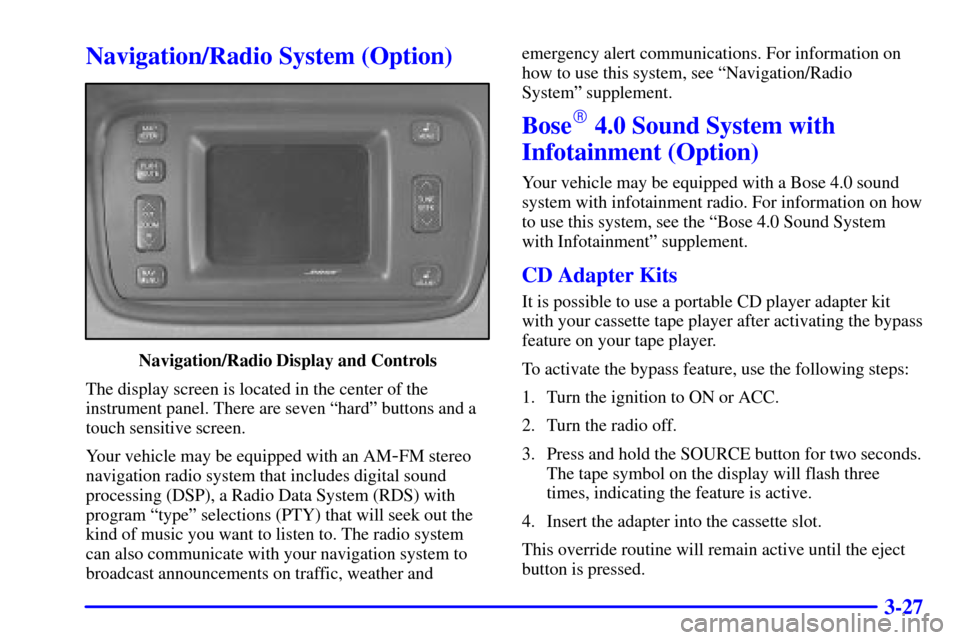
3-27
Navigation/Radio System (Option)
Navigation/Radio Display and Controls
The display screen is located in the center of the
instrument panel. There are seven ªhardº buttons and a
touch sensitive screen.
Your vehicle may be equipped with an AM
-FM stereo
navigation radio system that includes digital sound
processing (DSP), a Radio Data System (RDS) with
program ªtypeº selections (PTY) that will seek out the
kind of music you want to listen to. The radio system
can also communicate with your navigation system to
broadcast announcements on traffic, weather andemergency alert communications. For information on
how to use this system, see ªNavigation/Radio
Systemº supplement.
Bose� 4.0 Sound System with
Infotainment (Option)
Your vehicle may be equipped with a Bose 4.0 sound
system with infotainment radio. For information on how
to use this system, see the ªBose 4.0 Sound System
with Infotainmentº supplement.
CD Adapter Kits
It is possible to use a portable CD player adapter kit
with your cassette tape player after activating the bypass
feature on your tape player.
To activate the bypass feature, use the following steps:
1. Turn the ignition to ON or ACC.
2. Turn the radio off.
3. Press and hold the SOURCE button for two seconds.
The tape symbol on the display will flash three
times, indicating the feature is active.
4. Insert the adapter into the cassette slot.
This override routine will remain active until the eject
button is pressed.
Page 251 of 371
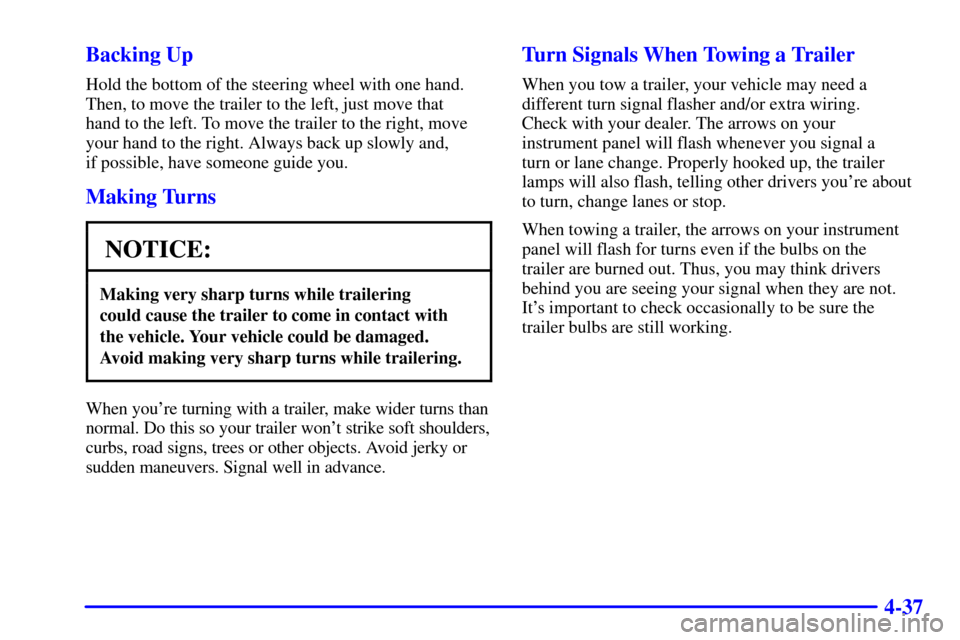
4-37 Backing Up
Hold the bottom of the steering wheel with one hand.
Then, to move the trailer to the left, just move that
hand to the left. To move the trailer to the right, move
your hand to the right. Always back up slowly and,
if possible, have someone guide you.
Making Turns
NOTICE:
Making very sharp turns while trailering
could cause the trailer to come in contact with
the vehicle. Your vehicle could be damaged.
Avoid making very sharp turns while trailering.
When you're turning with a trailer, make wider turns than
normal. Do this so your trailer won't strike soft shoulders,
curbs, road signs, trees or other objects. Avoid jerky or
sudden maneuvers. Signal well in advance.
Turn Signals When Towing a Trailer
When you tow a trailer, your vehicle may need a
different turn signal flasher and/or extra wiring.
Check with your dealer. The arrows on your
instrument panel will flash whenever you signal a
turn or lane change. Properly hooked up, the trailer
lamps will also flash, telling other drivers you're about
to turn, change lanes or stop.
When towing a trailer, the arrows on your instrument
panel will flash for turns even if the bulbs on the
trailer are burned out. Thus, you may think drivers
behind you are seeing your signal when they are not.
It's important to check occasionally to be sure the
trailer bulbs are still working.
Page 255 of 371
5-2
Hazard Warning Flashers
Your hazard warning flashers let you warn others. They
also let police know you have a problem. Your front and
rear turn signal lamps will flash on and off.
The hazard warning button
is located in the center
of the instrument panel,
between the two air vents.
Press the button in to make
the front and rear turn signal
lamps flash on and off.
This light located on the
instrument panel cluster
will flash, indicating
that the hazard warning
flashers are on.
Your hazard warning flashers work no matter what
position the key is in, and even if the key isn't in.
Press the button again to turn your hazard warning
flashers off. When the hazard warning flashers are on,
the turn signals won't work.
Page 262 of 371
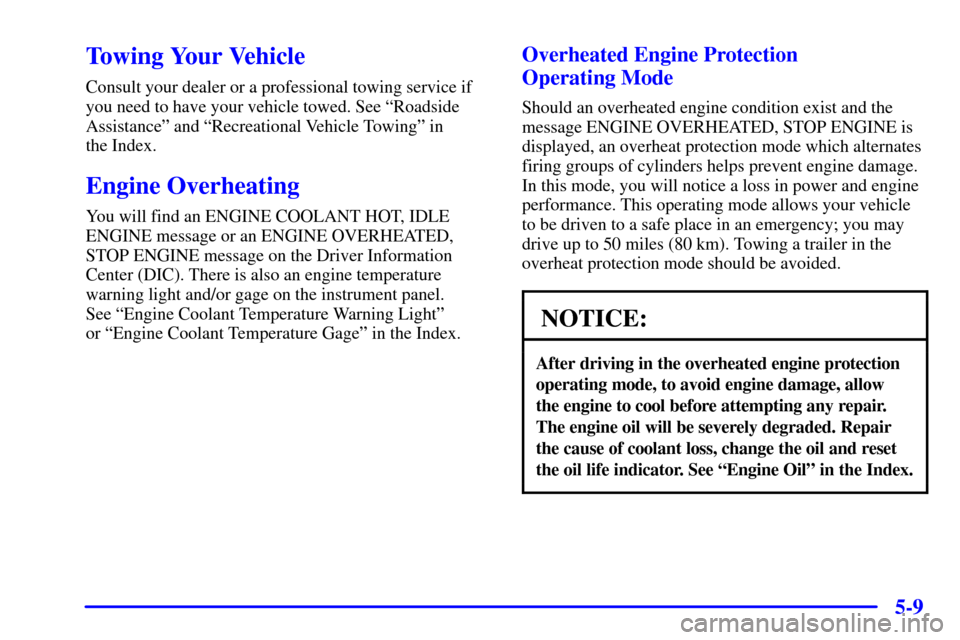
5-9
Towing Your Vehicle
Consult your dealer or a professional towing service if
you need to have your vehicle towed. See ªRoadside
Assistanceº and ªRecreational Vehicle Towingº in
the Index.
Engine Overheating
You will find an ENGINE COOLANT HOT, IDLE
ENGINE message or an ENGINE OVERHEATED,
STOP ENGINE message on the Driver Information
Center (DIC). There is also an engine temperature
warning light and/or gage on the instrument panel.
See ªEngine Coolant Temperature Warning Lightº
or ªEngine Coolant Temperature Gageº in the Index.
Overheated Engine Protection
Operating Mode
Should an overheated engine condition exist and the
message ENGINE OVERHEATED, STOP ENGINE is
displayed, an overheat protection mode which alternates
firing groups of cylinders helps prevent engine damage.
In this mode, you will notice a loss in power and engine
performance. This operating mode allows your vehicle
to be driven to a safe place in an emergency; you may
drive up to 50 miles (80 km). Towing a trailer in the
overheat protection mode should be avoided.
NOTICE:
After driving in the overheated engine protection
operating mode, to avoid engine damage, allow
the engine to cool before attempting any repair.
The engine oil will be severely degraded. Repair
the cause of coolant loss, change the oil and reset
the oil life indicator. See ªEngine Oilº in the Index.
Page 286 of 371

6-4
Be sure the posted octane for regular is at least 87
(at least 91 for premium). If the octane is less than 87,
you may get a heavy knocking noise when you drive.
If it's bad enough, it can damage your engine.
If you're using fuel rated at the recommended octane or
higher and you hear heavy knocking, your engine needs
service. But don't worry if you hear a little pinging
noise when you're accelerating or driving up a hill.
That's normal, and you don't have to buy a higher
octane fuel to get rid of pinging. It's the heavy,
constant knock that means you have a problem.
If your vehicle is certified to meet California Emission
Standards (indicated on the underhood emission control
label), it is designed to operate on fuels that meet
California specifications. If such fuels are not available
in states adopting California emissions standards,
your vehicle will operate satisfactorily on fuels meeting
federal specifications, but emission control system
performance may be affected. The malfunction indicator lamp on your instrument
panel may turn on and/or your vehicle may fail a
smog
-check test. See ªMalfunction Indicator Lampº
in the Index. If this occurs, return to your authorized
Cadillac dealer for diagnosis to determine the cause of
failure. In the event it is determined that the cause of the
condition is the type of fuels used, repairs may not be
covered by your warranty.
Some gasolines that are not reformulated for low
emissions may contain an octane
-enhancing additive
called methylcyclopentadienyl manganese tricarbonyl
(MMT); ask your service station operator whether or
not the fuel contains MMT. General Motors does not
recommend the use of such gasolines. If fuels containing
MMT are used, spark plug life may be reduced and your
emission control system performance may be affected.
The malfunction indicator lamp on your instrument
panel may turn on. If this occurs, return to your
authorized Cadillac dealer for service.